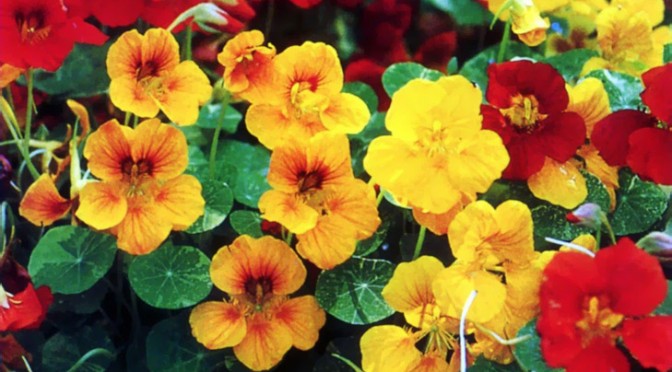Type: Seed (annual, freely seeding)
Soil Type: Prefers well-drained soil; recommend weakly acidic to weakly alkaline soil with pH between 6.1 and 7.8; does not like fertile soil – soil with too much nitrogen will produce fewer blooms
Sun Requirements: Full sun; in hotter areas, plant in partial shade
Best Planting Time: Indoors – 4 to 6 weeks before last frost date – beware of damping off; Outdoors – 14 days before last frost – thin to 30 cm apart
Important Characteristic: Can become invasive if not controlled; blooms are edible
Attracts: Hoverflies
Repels: Aphids and white flies; secrets thiophene, which may kill ‘root-knot nematodes’ – if you leave the root system in the ground, the effect against nematodes can last up to three years
Pests: Aphids, caterpillars, flea beetles, slugs, whiteflies
Companion Plants: – FAVORABLE – apples, beans, cabbage family, greenhouse crops, potatoes, pumpkins, radishes, squash – UNFAVORABLE – there do not seem to be any plants which act unfavorably when nasturtiums are near
Soil Benefits: N/A
Nasturtiums are an easy-to-grow edible annual flower which will flower quite nicely in poor soil. It prefers neutral soil with a pH rating of between between 6.1 and 7.8, so weakly acidic to weakly alkaline. As stated in the summary above, nasturtiums can be started indoors 4-6 weeks before the last frost or outdoors, 14 days before the last frost. Germination is easy and will generally occur within a few days. You can make germination easier by soaking the seeds 24 hours prior to planting.
Water regularly, but do not over-water. Nasturtiums thrive in full sunlight and prefer well-drained loamy or sandy soil and will even perform better in poor soil. If your climate is fairly hot, you can plant nasturtiums in partial shade to protect them from excessive heat. The hoverflies these plants attract will gobble up aphids on your other plants and vegetables. Seed pods containing 1 to 3 seeds will form at the base of the blooms and can either be allowed to drop, producing new plants the next season, or can be harvested and dried to plant in another area. These beauties will flower well into autumn and dead heading will ensure flourishing blooms. The blooms have a peppery flavor so can add spice to salad dishes or sandwiches.

